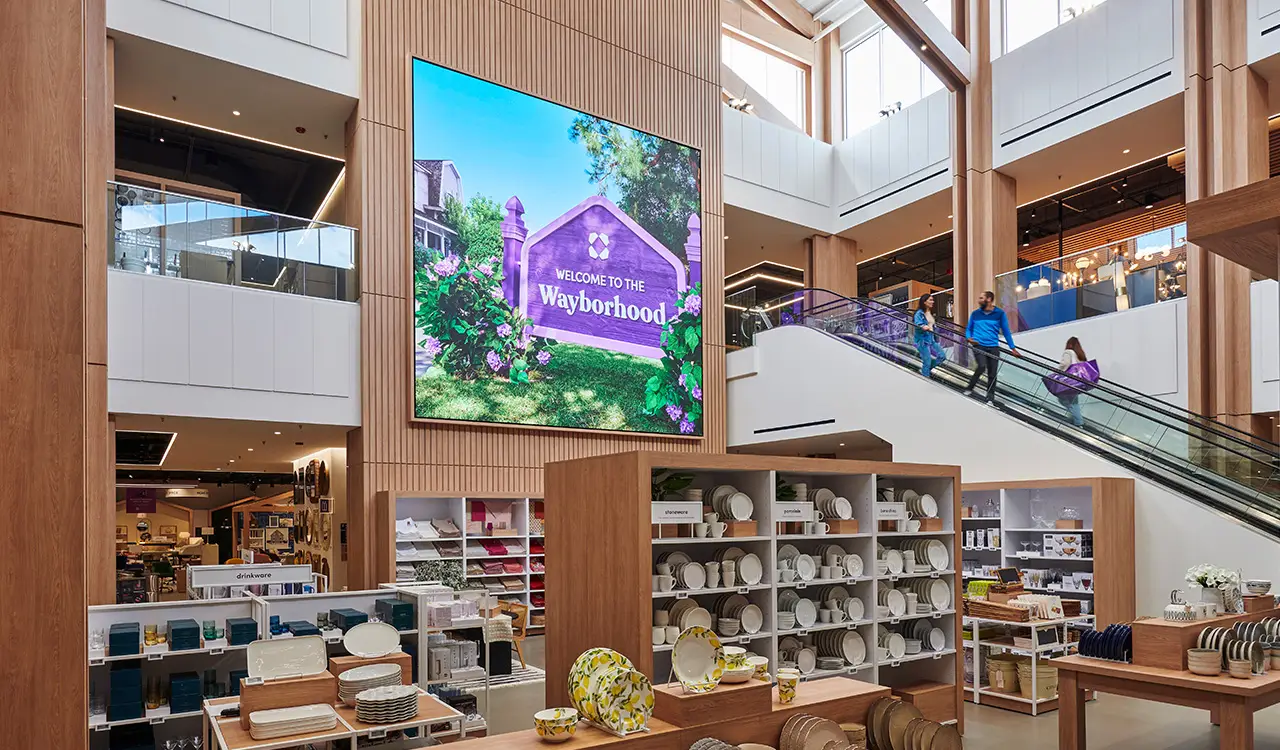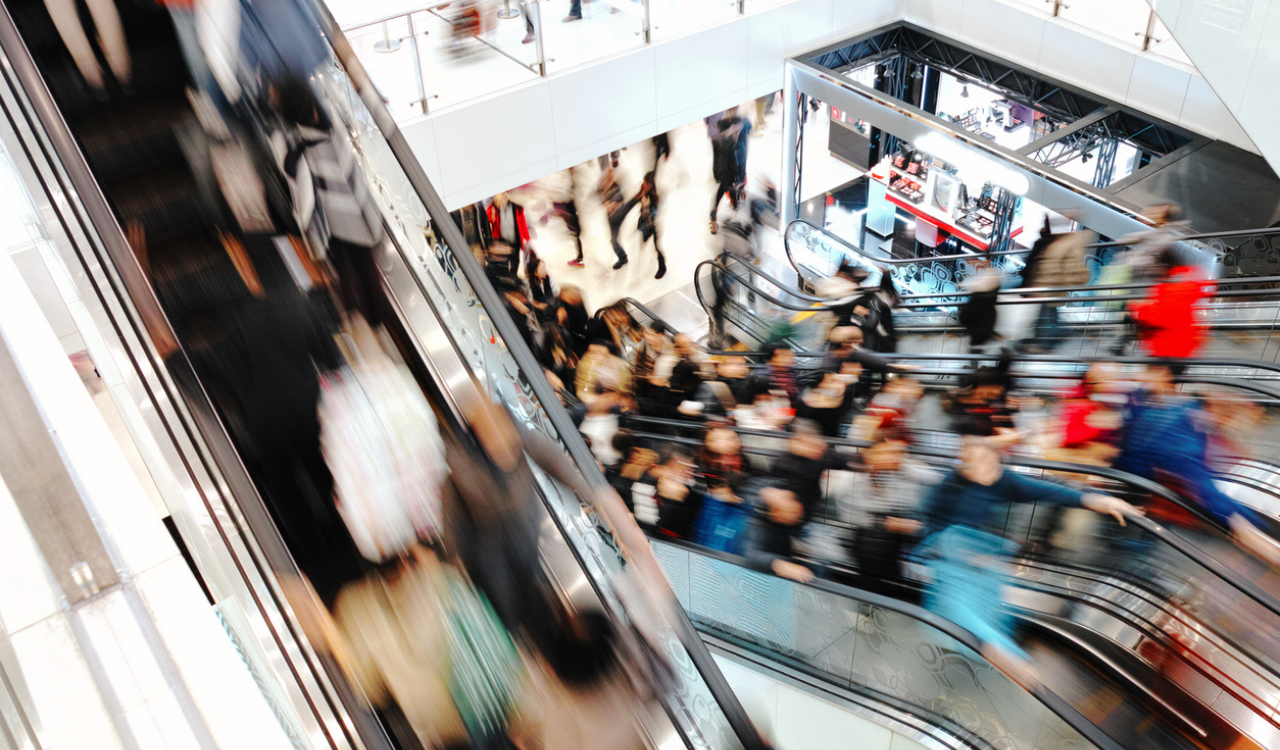Wayfair’s newly opened 150,000 square-foot flagship store in upscale Wilmette, Illinois has created much speculation about their future brick-and-mortar plans. Does the retail prototype foreshadow a major unified commerce push, or is it simply splashy retail theater to help mitigate Wayfair’s institutional investors’ anxiety about the company’s lack of profitability?
Wayfair needs to demonstrate a path to profitability, which has eluded them almost from the start. However, developing a cohesive sustainable offline strategy to complement their complex online model is a complex undertaking; one not readily measured by near-term metrics.
While the megastore is the first bearing the signature brand banner, Wayfair has eight other physical retail stores representing four other “Exclusive Brands.”
An Immersive Brand Experience
From a purely objective point of view, the Gensler-designed flagship does deliver on the essence of experiential retailing, the yin to ecommerce’s yang and many retail watchers have raved about the store’s overall design.
My Robin Report colleague Warren Shoulberg praised the over-the-top concept, which ticks all the boxes on great branded environments. He also chided Wayfair over its “cat and mouse” game played with the press regarding future physical stores.
Wayfair on the Record
When I put the question of Wayfair’s brick-and-mortar plans to a company spokesperson, the email response was: “While we expect ecommerce to continue to grow strongly, physical retail will remain a primary channel for consumers in this category. As for future plans for physical retail, we do expect to have a portfolio of stores in the U.S. over time.”
This echoed another Shoulberg comment: “There’s only one thing worse than opening new stores too quickly: that’s opening them too slowly.” And while I share his sense of urgency, my view is tempered by the recent history of digital native brands’ migration to brick-and-mortar retail. It has been a tale fraught with challenges and missteps; more on that to come. So, what’s the best path forward for Wayfair, and are the fundamental issues magnified by the megastore effort?
The Wayfair-Way
Wayfair needs to demonstrate a path to profitability, which has eluded them almost from the start. However, developing a cohesive sustainable offline strategy to complement their complex online model is a complex undertaking; one not readily measured by near-term metrics.
Wayfair helped get me up-to-speed on the “Wayfair-Way” including data from their 2023 Investor Day shareholder meeting. My intent was to gain some insights behind the big-box effort perhaps suggesting what’s next. Here are some takeaways:
- Wayfair’s offerings fall into three categories, Branded, Differentiated and Commodity.
- Branded – 25 percent of annual revenue. These non-exclusive national brands are “price-matching” which limit sales margins.
- Differentiated or Exclusive Brands – 70 percent of annual revenue. These include all products under the Wayfair banner generating greater profit margins.
- Commodity – 5 percent of annual revenue. These brands are common to many online and offline sellers. Wayfair’s pricing makes it hard to be the low-price leader.
- Wayfair’s Differentiated brands fall into three segments:
- Luxury for households with $175K+ incomes
- Mass for households with $60K-$175K income and
- Economy for households with $60K income and below.
Brand Complexity
Now things get complicated. Besides the overarching “mothership” Wayfair brand, there are four “sister brands.” These include Perigold, AllModern (with three stores), Joss & Main (with two stores), and Birch Lane (with three stores, and a fourth pending). These brands can be found on Wayfair’s website, as well as their own branded sites.
The brand positioning lacks clarity. Perigold is clearly considered luxury. AllModern, Birch Lane, and Joss & Main appear to staddle both luxury and mass. Wayfair brand straddles all three, luxury, mass, and economy. It also boasts an additional 12 specialty private label brands (including Kelly Clarkson) that cross nine different style categories.
This “more is better” approach to brand architecture is very old-school. It’s been shown time and again to impair rather than promote decision-making and complicate operations. Additionally, these issues could well be contributing to Wayfair’s bleeding bottom line. But wait there’s more! We’ve not even addressed Wayfair’s online third-party sellers, boasting over 5,000 brands, and selling over 33 million products from 23,000 distributors.
Wayfair enters the “digital-to-phygital” realm with much muddy water under the bridge. Digital-native retailers like Bonobos, Warby Parker, Casper, Allbirds, et al., have indeed demonstrated a synergy between online and offline retail. But the offline move for these and other digital natives has been a very bumpy ride, like off-roading, Baja-style.
Moreover, comparing Wayfair to these vertically integrated digital natives is like comparing apples to artichokes. Besides Wayfair’s plethora of private brands, being a third-party marketplace gives them little control over their supply chain.
Amazon is the prime example of how difficult it can be (or was) for a third-party ecommerce marketplace to become channel agnostic. We have all witnessed the “big dog marketplace” open stores, dozens of them, only to close them all. And it wasn’t without spending boatloads of money, something Wayfair lacks.
It’s also worth noting that comparing the returns management between Amazon and Wayfair is more apples and artichokes. Sending a book, dress, or kitchen spatula back to Amazon is rather rudimentary. Returning the wrong color living room sofa, or one that accidentally fell out of the delivery truck to Wayfair is something else, entirely.
Nothing Unified About One Flagship
Throughout my four-decade career as a retail planner, designer and trend forecaster my firm was responsible for the planning and design of numerous prototype and flagship stores. Given this history and my recent deep dive into “the Wayfair Way” I had certain preconceptions of what Wayfair’s flagship store might look like. I was wrong.
While the design of the Wilmette store is exceptional, the mission given to the design group feels like “putting the internet of all things home related into a box.” They did that well. But I question the veracity of that mission.
I’m a huge proponent of unified commerce and was beating that drum back at the turn of the millennium. However, in an era of unified commerce, the actual in-store experience should augment, not replicate the online offering. And given Wayfair’s need to shine a high-lumen light on its profitable differentiated products and exclusive brands, the in-store representation of those high-margin brands felt like an afterthought at best. There was a far greater representation of major national brands and commodity offerings.
The store’s “all things to all people” approach feels like the reincarnation of Home Depot EXPO, which did not end well. Lululemon’s former CEO and founder Chip Wilson said in early 2024, “I think the definition of a brand is that you’re not everything to everybody.” Put another way, Steve Jobs used to say, “What we don’t do is as important as what we will do.”
Experiencing the Wayborhood
Central to the store’s design was the creation of “The Wayborhood,” featuring 19 departments with themed neighborhoods. However, rather than highlighting Wayfair’s differentiated, private label brands, shoppers are confronted with a plethora of national brands, reflecting the inventory of multiple big box retailers and specialized ecommerce sites.
This includes core categories and offerings seen at Ikea (kitchen, bath, lighting fixtures); Best Buy (major kitchen appliances); as well as Lowe’s and Home Depot (plumbing fixtures, lighting, tile, patio and grills).
That said, Wayfair has done a far superior job in the curation, impeccable organization, and display design over any of the big boxes. Also impressive are the digital price labels equipped with QR codes to enable customers to access detailed information. This was leading-edge stuff.
Like Ikea, Wayfair features fully staged rooms to amplify styles and lifestyle themes. But Wayfair feels less “immersive” by comparison. Rather than leaning into Ikea’s “pathway-past-everything,” Wayfair promotes a “choose one’s own adventure.” While the store has the expected wayfinding signage, the Wayfair layout provides few clues as to how to “shop” the store.
Without the comfort of Ikea’s “guided experience” customers often default to a mission-driven plan, scoping out isolated departments and missing out on the “I didn’t know I needed that” discovery. Additionally, such “targeted visits” run counter to the retailer’s objective of extending the shoppers’ stay.
Rx For What’s Next
I believe that there are some strategic and tactical decisions that can aid in becoming a bona fide unified commerce retailer:
- Downsize Offline Footprint. It would be prudent to focus on creating a half-dozen, under 20,000 square-foot stores. A more manageable group of strategically located prototypes could become better “laboratories” to determine what works.
- Cleaned Up Brand Architecture. Brands only matter when they have meaning. Better clarity around the brand attributes, styles and target audiences of their exclusive brands should yield greater brand value while simplifying marketing and operations. Styles come and go, customers like what they like, regardless of nomenclature.
- Lean into Differentiated Offerings. With so much ubiquity and commoditization in the marketplace, more commodity-filled boxes (like Bed Bath & Beyond) are not warranted. Wayfair’s high margin, “Differentiated” exclusive brands are their best vehicle to move toward “black ink.”
- Curate, Curate. Williams Sonoma’s Pottery Barn and West Elm have become successful omnichannel retailers by complementing online and catalog with stores that offer a limited stock of selected pieces in popular finishes and fabrics. This promotes in-store pick-up or drop ship, while still offering customization and endless aisle choice-making, without wasting space on low-margin SKU’s.
- Build On Personal Services. Working showerheads are cool but design centers featuring the latest in AR like Wayfair’s “View in Room,” augmented by in-house professional design services (à la Ikea, Crate & Barrel) are powerful tools to build customer lifetime value (CLV).
- Don’t Forget the Experience. Immersive retail only works if it’s truly dynamic and ever-changing. Wayfair might consider involving professional designers and design students to restyle and restage room vignettes on a rotating basis. Then have micro-influencers cover these and other real experiences on social media to create a sense of retail theater. Creating an inviting environment for design professionals and clients would also yield great returns.





